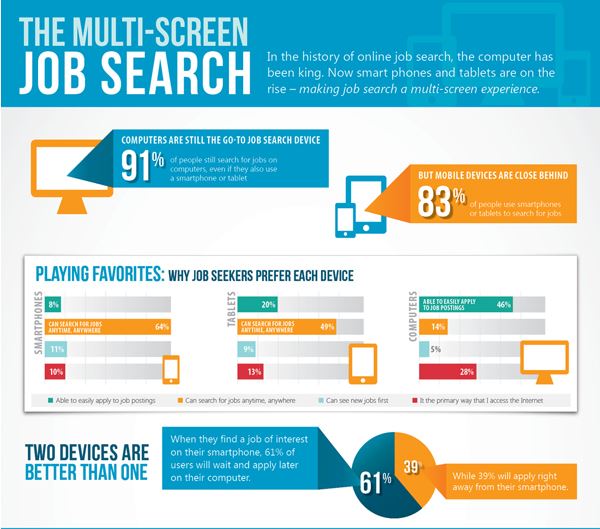 As the Director of Membership at NPAworldwide, a recruitment network, I am often asked this question: So who runs this network? As a network that is member-owned and run, this is a multitiered question at best, and does not apply to every online network that you may find. However, here is the breakdown of what is happening behind the scenes at our specific split-placement network. Read the rest of this entry »
As the Director of Membership at NPAworldwide, a recruitment network, I am often asked this question: So who runs this network? As a network that is member-owned and run, this is a multitiered question at best, and does not apply to every online network that you may find. However, here is the breakdown of what is happening behind the scenes at our specific split-placement network. Read the rest of this entry »
Behind the Scenes of a Global Recruitment Network
by Sarah FreiburgerMobile Job Search Is the New Normal
by Veronica BlattIt’s official. Mobile job search is mainstream. Earlier this week, Indeed announced its acquisition of MoBolt, a technology platform that allows job seekers to apply directly for any job, from any device. Further, in the same announcement, Indeed reported that half of all Indeed job searches are performed on a mobile device. Yet only a small percentage of Fortune 500 employers provide a fully-mobile job application process. The Indeed/MoBolt relationship means virtually any employer can now accept mobile job applications, without any IT integration.
A recent infographic from Beyond.com indicates that 64% of job seekers prefer to use a smartphone for job search activities because they can search for jobs anytime, anywhere. However, only 8% of survey respondents indicate that it is EASY to apply for a job via their smartphone. Nearly two-thirds of respondents said when they find a job of interest on their smartphone, they wait until later to apply via a desktop computer. Click the image below for the full infographic:
And here’s the rub: other research indicates that job applications must be received within the first 72 hours after posting or are 50% less likely to even be opened. Forcing job seekers to ‘come back later’ because the mobile application process is so cumbersome means a lot of job seekers won’t come back. Glassdoor says that 75% of job seekers will conduct a mobile job SEARCH, but only 44% will APPLY via a mobile device. That means employers could be losing out on almost half of potential applicants. In a talent short market, who can afford to lose out on even ONE great applicant?
That leads me to my final point. One of the current hindrances to applying via a mobile device is that most people do not have a copy of their resume stored on their mobile device. And most career sites still require a resume to be uploaded. So I ask, is it finally time to replace traditional paper-based resumes with a digital alternative? LinkedIn offers the ability to apply using your LinkedIn profile, but many profiles lack polish or aren’t up-to-date, and not all candidates are using LinkedIn. Similarly, Indeed offers an “Apply with Indeed” button (ZipRecruiter offers an interesting comparison between the two here), which works well for employers who post on Indeed and job seekers who search with Indeed. True, that represents a lot of employers and a lot of job seekers — but not all of them. And not necessarily the right ones. Could a link to a digital portfolio be an acceptable alternative? Can recruiters and employers and candidates (and ATS’) leverage the visual content trend so that it works for everyone? In my opinion, recruiters and employers who figure out how to turn mobile job search into mobile job applications (with a great user experience) stand to win the talent war big-time.
What are your thoughts on the disconnect between mobile job search and mobile job applications? How are you adjusting your process to accommodate mobile usage?
10 Recruitment Trends to Watch
by Dave Nerz Following visits to several conferences in the past 10 months, I thought I should capture some of the recruitment trends that are becoming evident. Read the rest of this entry »
Following visits to several conferences in the past 10 months, I thought I should capture some of the recruitment trends that are becoming evident. Read the rest of this entry »
Gain a Competitive Advantage with Video
by Veronica Blatt Today’s guest blogger is Alison Pruett, Marketing Manager of InterviewStream – the pioneer in online video interviewing. Since 2003, InterviewStream (an NPAworldwide Alliance Partner) has helped companies generate great candidate experiences and remarkable returns through Web-based video screening, interviewing and preparation. InterviewStream provides a best-practice-based approach and a flexible adoption model that works with customers’ unique needs and business goals to achieve breakthrough results. Clients rely on InterviewStream for the perfect combination of proven value and endless possibility.
Today’s guest blogger is Alison Pruett, Marketing Manager of InterviewStream – the pioneer in online video interviewing. Since 2003, InterviewStream (an NPAworldwide Alliance Partner) has helped companies generate great candidate experiences and remarkable returns through Web-based video screening, interviewing and preparation. InterviewStream provides a best-practice-based approach and a flexible adoption model that works with customers’ unique needs and business goals to achieve breakthrough results. Clients rely on InterviewStream for the perfect combination of proven value and endless possibility.
The world of staffing will always be highly competitive. Staffing firms and RPOs must compete with each other to find the best talent, and talent acquisition professionals must always effectively sell their candidates to hiring managers. Firms, at their most basic level, must fight each other to get as many placements as possible to increase revenue and grow their brand. Read the rest of this entry »
Outsourcing and the Future of Global Recruitment
by Veronica Blatt Today’s post is from Nerissa Reyes from AVANTI People Partnership International in Manila, Philippines. Nerissa is currently serving as secretary/treasurer of NPA’s board of directors and was previously a regional director for the recruitment network. She lives and works across several countries including Jakarta, Sydney and Manila.
Today’s post is from Nerissa Reyes from AVANTI People Partnership International in Manila, Philippines. Nerissa is currently serving as secretary/treasurer of NPA’s board of directors and was previously a regional director for the recruitment network. She lives and works across several countries including Jakarta, Sydney and Manila.
AVANTI People Partnership provides executive search and staffing for various multinational companies across functions. In the fast-growing “business process outsourcing” arena, AVANTI provides cross-border recruitment solutions on a global scale.
I have experienced the phenomenal growth of the outsourcing industry in the Philippines. Multinational and medium-sized companies have insourced/outsourced their operations from customer contact centres to back office support. The level of outsourced operations ranges from the simple “chat” to IT development or knowledge-based data analysis.
RPO, or recruitment process outsourcing, is done in cost-effective centres in Asia, Europe, and Latin America. It provides the client flexibility in the recruitment process without the burden of permanent employees. RPO services start with data gathering and market research to determine the search strategy for the client. The RPO service provider will then manage the entire recruitment process including job ads, candidate interviews, shortlisting, and reference checks. Their search may include the engagement of a recruitment firm for specialized roles.
Recruitment firms have also outsourced their support operations offshore. Candidate research, database administration, interviews, and scheduling can be processed overseas. This enables the recruitment consultant to focus on client-relationship management locally.
There are pros and cons to outsourcing. The advantages are cost consideration and workforce flexibility enabled by technology. However, knowledge of the local market is limited, lack of control, and quality of service could be compromised.
Due to the cyclical nature of recruitment and the global downturn of several industries, companies will continue to look for solutions. For recruitment firms that are struggling to remain profitable, outsourcing could create new opportunities by providing alternative ways of doing business, decreasing overhead cost while increasing the database of clients and candidates. Even a small local recruitment firm can provide global outsourcing solutions to clients/candidates in their own backyard through its network of associates.
Dynamic companies are always seeking for global opportunities. There are no borders to international business, creating the demand for global recruitment.
Are you challenged to go beyond your comfort zone towards a global recruitment business?
Manpower Releases Global Employment Outlook
by Veronica Blatt Manpower’s quarterly Global Employment Outlook indicates that opportunities for job seekers across most major labor markets are expected to remain positive throughout the third quarter. Only four countries (Italy, Belgium, France, and the Netherlands) report a negative hiring outlook during this time span. Hiring plans are less strong than the previous quarter, but higher on a year-over-year basis. For this report, ManpowerGroup surveyed more than 65,000 employers from 42 different countries and territories. Key take-aways include: Read the rest of this entry »
Manpower’s quarterly Global Employment Outlook indicates that opportunities for job seekers across most major labor markets are expected to remain positive throughout the third quarter. Only four countries (Italy, Belgium, France, and the Netherlands) report a negative hiring outlook during this time span. Hiring plans are less strong than the previous quarter, but higher on a year-over-year basis. For this report, ManpowerGroup surveyed more than 65,000 employers from 42 different countries and territories. Key take-aways include: Read the rest of this entry »
Ten Top Tips for Time Management
by Veronica Blatt Mel Kettle is a communications and social media consultant, speaker, blogger, educator, coach, bookworm, obsessive foodie and eatie, and a budding photographer. She blogs on marketing and social media at www.melkettle.com.au. Mel is passionate about working with organisations to show them how to communicate effectively so they can develop communities, share their stories and raise awareness. She particularly enjoys working with people who want to make a difference to other people’s lives. In her spare time Mel writes a food blog, The cook’s notebook.
Mel Kettle is a communications and social media consultant, speaker, blogger, educator, coach, bookworm, obsessive foodie and eatie, and a budding photographer. She blogs on marketing and social media at www.melkettle.com.au. Mel is passionate about working with organisations to show them how to communicate effectively so they can develop communities, share their stories and raise awareness. She particularly enjoys working with people who want to make a difference to other people’s lives. In her spare time Mel writes a food blog, The cook’s notebook.
In today’s highly connected age, where everyone just seems to be BUSY, BUSY, BUSY, time seems to be more and more difficult to manage. At least, that’s often how I feel. And whether you run your own business, or you work for another, the demands on your time sometimes seem endless. Read the rest of this entry »
Global Recruiters: Candidates Are Ready for Relocation
by Dave Nerz Gallup did a poll and asked US residents if they would move away from their states, given the chance. The results were pretty amazing. In nine US states, more than 40% of those polled were ready and willing to move.
Gallup did a poll and asked US residents if they would move away from their states, given the chance. The results were pretty amazing. In nine US states, more than 40% of those polled were ready and willing to move.
What does that tell you? Well for one, the states were mostly cold weather states and we just had a doozy of a winter. Secondly, some of the states are states with few new jobs or an overall lack of jobs. Candidate relocation for better employment in on the rise. The states listed as “ready to leave” states were: Read the rest of this entry »
The Elusive Pink Squirrel: The Independent Firm Right for a Recruitment Network
by Sarah Freiburger If the purple squirrel is a metaphor used by recruiters and HR to describe the perfect job candidate, then I would like to present the Pink Squirrel. As the Director of Membership for NPAworldwide, a recruitment network, I search for these each day. The Pink Squirrel is that hard-to-find recruiting agency that loves to build relationships with other recruiters and make split placements, and in the large world of recruitment agencies where business models differ greatly, it is quite difficult to qualify a firm to meet the standards of a split placement network. Here are five key qualifying factors I consider during my hunt for these pink squirrels. Read the rest of this entry »
If the purple squirrel is a metaphor used by recruiters and HR to describe the perfect job candidate, then I would like to present the Pink Squirrel. As the Director of Membership for NPAworldwide, a recruitment network, I search for these each day. The Pink Squirrel is that hard-to-find recruiting agency that loves to build relationships with other recruiters and make split placements, and in the large world of recruitment agencies where business models differ greatly, it is quite difficult to qualify a firm to meet the standards of a split placement network. Here are five key qualifying factors I consider during my hunt for these pink squirrels. Read the rest of this entry »



